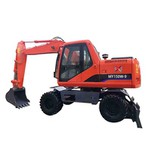Bulldozers are extremely effective pieces of heavy machinery, but not everyone knows how they work or appreciates their power. To pay homage to this incredible marvel of engineering, we put together a short article on the basis of the bulldozer. Read on to learn something new and build up knowledge that's sure to impress any of your gearhead buddies.
What is a bulldozer? How does it work?
Most people don't realize this, but bulldozers are actually classified as tractors first! The difference between a bulldozer and a farm tractor is the metal plate (also called the blade) on the front of the bulldozer. However, similar to tractors, bulldozers are used to push large amounts of debris and raw materials, including sand, rocks, dirt, and bricks.
A bulldozer's work is largely due to the force exerted by its tracking system. Tracks (such as endless belts) that rotate around the base of the bulldozer give it considerable flexibility over rough terrain and the ability to transport and hold heavy loads.
Other important parts of a dozer are the ripper and blade. As mentioned previously, the blade is often used interchangeably with the "slab" to refer to the large metal structure at the front of the dozer. This is the part responsible for doing the re-promotion.
The dozer's ripper is located on the other side of the blade, all the way to the rear of the machine. As the name suggests, the device "rips apart" the ground and material covered by the bulldozer. It's shaped like a claw and creates a powerful shearing effect. If the ground is packed tightly together or compacted, a ripper will bring the soil to a softer, easier-to-work condition.
What can a bulldozer be used for?
Most commonly, bulldozers are used for demolition purposes. Considering their massive size and claw-like extensions, this isn't surprising! But bulldozers do more than just damage. In fact, they are often used for many other purposes.
Earthmoving is one of the next most common applications for bulldozers. The front blade of the machine pushes up dirt, soil, sand, or any "dirt" that needs to be moved.
Bulldozers are also used in construction projects and land clearing. It is not uncommon for an area to need to be cleared of brush and natural vegetation before construction excavation or construction can begin. Bulldozers accomplish this task in one fell swoop, removing unwanted trees, brush, and sometimes, if the land is not managed well, garbage and other debris.
Finally, bulldozers can be used to build roads and sidewalks. Just like a construction site needs to be cleared of existing vegetation before the project can begin, the roadway also needs to be properly cleared and graded to a flat surface before any paving or covering can begin.

Why use a Bulldozer Machine?
Like most heavy machines, bulldozers are designed to make our jobs and lives easier. If you work in any industry that requires moving or physically modifying large amounts of material, you may be inclined to use a dozer. This includes construction, agriculture, civil engineering, demolition, home improvement and more.
Although the original design is still essentially what most people use today, the dozer has been improved and modified to expand its range of applications and effectiveness. In the field of combat engineering, dozers may be equipped with armor to increase durability and protect the operator. Perhaps even more exciting, especially for construction managers, there are now remotely operated dozers on the market that allow operators to control heavy machinery from a safe distance. This allows them to perform jobs that may put workers in dangerous or uncomfortable situations, whether those situations are related to weather conditions, falling debris or threats from surrounding equipment.








